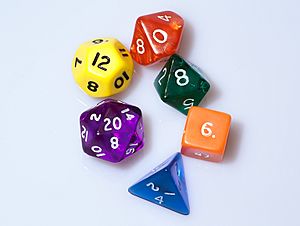- This page was last modified on 17 October 2025, at 10:18. Suggest an edit.
Dungeons & Dragons facts for kids
Dungeons & Dragons is a fun roleplaying game that you play with friends using your imagination. It's often called D&D. Gary Gygax and Dave Arneson created this game in 1974.
Many people think roleplaying games (RPGs) are only on computers. But D&D is a "tabletop" game. Players sit around a table and use their minds to create a story together. They follow rules and roll dice to see what happens.
In D&D, you play as an imaginary character. Your character goes on exciting adventures. You could be a brave warrior, a clever wizard, or a sneaky thief. One player is the "Dungeon Master" (DM). The DM is like a storyteller and referee. They make sure the rules are followed and create the adventure for everyone.
There are many types of fantasy roleplaying games today. Some are tabletop games like D&D, and some are computer games. These games can be about fantasy, science fiction, or even horror.
Contents
What is Dungeons & Dragons?
Dungeons & Dragons is a game where you tell stories with your friends. You pretend to be a hero in a magical world. The game uses rulebooks and dice to help you play.
How D&D Works
One person is the Dungeon Master (DM). The DM describes the world and the challenges. The other players create their own characters. These characters explore dungeons, fight monsters, and solve puzzles.
The game is like a shared story. Everyone helps make it happen. You use your imagination to picture the world and your character's actions.
Different Versions of D&D
Over the years, Dungeons & Dragons has changed. Several versions of the game have been released. Each version updates the rules and how the game is played.
The very first version was simply called "Dungeons & Dragons." It had different rule books for characters as they became stronger.
Later, a new set of rules came out called Advanced Dungeons and Dragons (AD&D). A second edition of AD&D was also released. Many players still enjoy this version today.
When Wizards of the Coast bought D&D, they made a simpler version. This was called Dungeons and Dragons 3rd Edition. It made most die rolls use a 20-sided die. This made the game easier to learn.
The 3rd edition rules were later improved and became version 3.5. Then, the 4th edition rules were published in 2008. The newest version, the 5th edition, came out in 2014. It was tested by players for two years before it was released.
Playing Dungeons & Dragons
Before you start playing D&D, you need to create your own character. You write down all your character's details on a "character sheet."
Creating Your Character
First, you decide your character's six main strengths, called "ability scores":
- Strength: How strong your character is.
- Dexterity: How quick and skilled your character is.
- Constitution: How tough and healthy your character is.
- Intelligence: How smart and knowledgeable your character is.
- Wisdom: How well your character understands things and makes good choices.
- Charisma: How well your character can influence or talk to others.
Each version of D&D has different ways to figure out these scores.
Next, you choose your character's race, like a human or an elf. You also pick a class, which is like their job. This could be a Fighter or a Wizard. You also choose their alignment, which is their moral view. For example, are they good or evil?
You can also give your character special skills, feats, and powers. These make your character stronger. You can also add details like their history and personality. This helps make your character unique.
How the Game is Played
During the game, players tell the DM what their characters want to do. For example, they might say, "I want to hit the monster!" or "I want to hide from the guards." The DM then describes what happens.
If an action is easy, like opening an unlocked door, it just works. But for harder actions, you roll dice. The dice roll helps decide if your character succeeds or fails.
Character Growth
As you play, your character grows and gets stronger. They can gain experience, new skills, and wealth. Characters usually gain experience by defeating enemies or completing important tasks. When you get enough experience, your character gains a level. This gives them more job abilities, skills, and powers.
Your character's health is measured by "Hit Points" (HP). When your character gets hurt, they lose HP. If they lose all their HP, they might die. To avoid getting hurt, characters can wear different types of armor. They can also make "Saving Throws" to avoid things like poison or magic spells.
The story in D&D is created by everyone playing. The DM might have a story ready, or you might make it up together. The setting, which is where the adventure takes place, can also be made up. There are also books that provide ready-made stories and settings.
Images for kids
See also
 In Spanish: Dungeons & Dragons para niños
In Spanish: Dungeons & Dragons para niños




